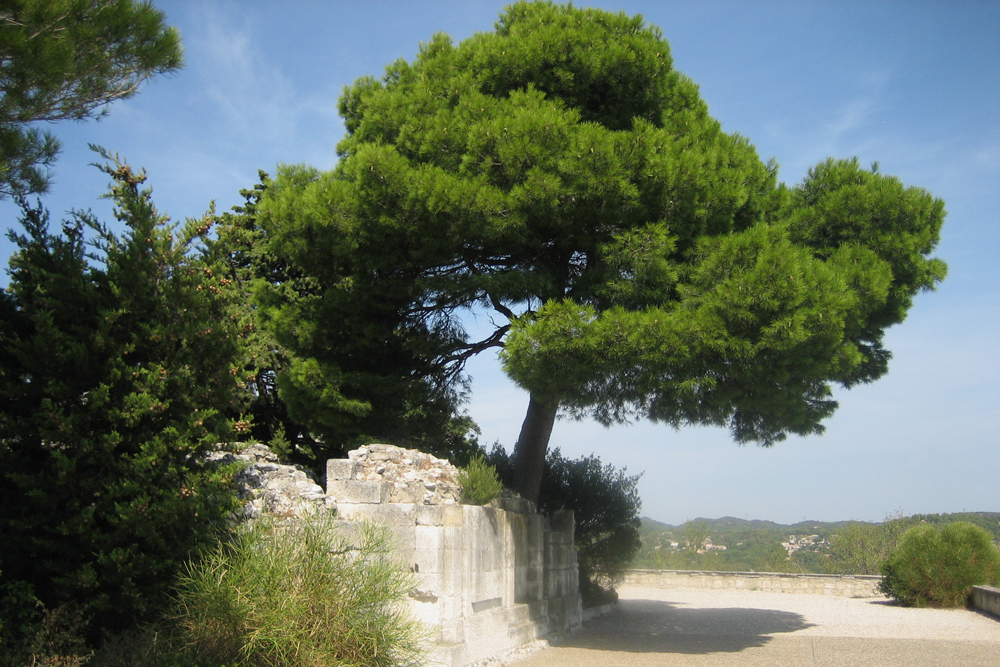September 2009 – A day visiting gardens in Villeneuve-lez-Avignon
Our autumn 2009 programme began with a full day of activities at Villeneuve-lez-Avignon. The first visit of the day was to Fort Saint-André, commissioned in 1292 by Philippe le Bel, King of France, to affirm royal power, as opposed to the Papal power in force across the Rhône in Avignon. Inside the Fort, the focus of our visit was the Benedictine Abbaye Saint-André and its very significant Provençal garden.
The owner of the fort, Mlle Roseline Bacou, personally welcomed our party and charmed us all with a fascinating tour of her home. The detailed and vivid description of her family’s acquisition of the property and of her personal involvement with the renovation of both the Abbaye and garden were fascinating.
After the tour of the building we began our discovery of the garden by wandered through the extensive and immaculately maintained Italian gardens, the refurbishment of which began in the 1920s. Terraces, paths and passages link a number of formal gardens, shrubberies and an olive orchard. Much emphasis is placed on Mediterranean planting and, significantly for us, there is minimal irrigation. The garden includes many fine trees, the top of the property being dominated by wonderful old Aleppo pines (Pinus halepensis), sculpted, not surprisingly given the Fort’s location, by the onslaught of the Mistral. Tall cypresses (Cupressus sempervirens) and huge box trees (Buxus sempervirens) feature throughout the garden. For our group photograph we stood on the entrance steps of the Abbaye and admired two very old and significant trees, an Arbre de Judée (Cercis siliquastrum) and a very ancient Sophora japonica.
The afternoon began with a tour of the Chartreuse du Val-de-Bénédiction constructed by Pope Innocent VI and one of the largest Carthusian monasteries in Europe. Carthusian monasteries typically represented a balance between the mineral and the vegetable world. With the benefit of an excellent and enthusiastic guide, we admired frescoes by Matteo Giovanetti, explored the three cloisters and visited one of the 40 monastic cells, each of which had its own individual garden.
‘Le jardin des simples’ recreates a typical example, showing how each monk was able to select his own choice of medicinal plants and vegetables and even flowers for ornamental use.
Medicinal plants commonly grown in these compact spaces included mallow (Malva sylvestris), which mixed with olive oil was a deterrent against bee stings, plantain for use against snakebites and mint for the common cold.
Other gardens within the monastery included ‘Le cloître du cimetière’ with a generous planting of cypress, the typical Provençal symbol of immortality and the ‘Jardin du procureur’. This was originally planted in the 18th century by keen plantsman Dom Alexandre Perraud, and included such exotics as oranges and pomegranates, the fruit of the latter symbolising the unity of the church.
We concluded our day in the charming garden at the Hôtel Le Prieuré. After pausing to admire the 23 metre rose arch planted in the 1940s and the formal garden laid out by Francois Dedieu, interest centred on the refreshments and shade of the pergola.
On this outing we were able to welcome eight new members drawn from the Hérault, the Gard and the Vaucluse.
Thanks to Christine for organising our first event of the new season.
Text: Duncan Munford
Photos: Duncan Munford and Chantal Maurice
![]()





